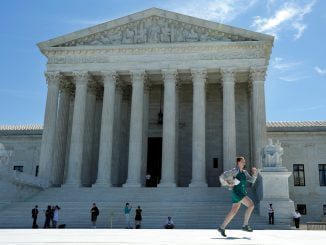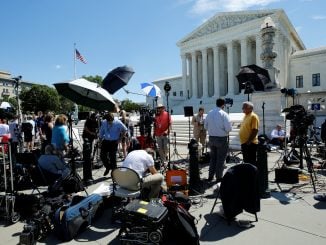WASHINGTON, D.C. — The biggest cases of the Supreme Court term so far have a surprising common thread.
On a court with five Republican appointees, the liberal justices have been in the majority in rulings that make workplace discrimination against gay and transgender people illegal, protect young immigrants from deportation and, as of Monday, struck down a Louisiana law that restricted abortion providers.
As surprising, Chief Justice John Roberts, nominated by President George W. Bush who has led the court for nearly 15 years, has joined his liberal colleagues in all three.
Since the retirement of Justice Anthony Kennedy in 2018, Roberts has played a pivotal role in determining how far the court will go in cases where the court’s four liberals and four conservatives are closely divided.
Here’s a look at where Roberts stood in the abortion, immigration and LGBT cases; his history on the court; and what’s at stake in coming decisions in which Roberts could play a key role:
ABORTION
On Monday, Roberts joined liberal justices Ruth Bader Ginsburg, Stephen Breyer, Sonia Sotomayor and Elena Kagan in striking down Louisiana’s Act 620. The justices ruled that the law requiring doctors who perform abortions to have admitting privileges at nearby hospitals violates the abortion rights the court first announced in the landmark 1973 Roe v. Wade decision.
But Roberts’ reason for siding with the liberals had less to do with his feelings on abortion than with his feelings on whether the court should do an abrupt about-face. Four years ago, the court’s four liberal members and Justice Kennedy struck down a Texas law nearly identical to Louisiana’s. At the time, Roberts was a vote in dissent. But with Kennedy’s retirement and replacement by conservative Justice Brett Kavanaugh, many conservatives had hoped the result in the Louisiana case would be different. Not so, Roberts wrote: “The result in this case is controlled by our decision four years ago.”
IMMIGRATION
On June 18, the court ruled 5-4 against the Trump administration, saying it did not take the proper steps to end the 8-year-old Deferred Action for Childhood Arrivals program, which protects some 650,000 young immigrants from deportation. Roberts wrote the court’s opinion, joined by the four liberal justices.
Everyone agreed that the administration can end DACA, but the dispute was whether it had been done properly. Roberts said no, writing that the administration had, among other things, failed to consider “what if anything to do about the hardship to DACA recipients.”
Trump has already said he will renew his effort to end DACA.
LGBT RIGHTS
The court’s immigration ruling followed just days after its June 15 ruling that a landmark civil rights law protects LGBT people from discrimination in employment. The ruling didn’t divide the court like the abortion and immigration rulings, however. Six of the justices — Roberts, the court’s four liberals and Trump appointee Neil Gorsuch — ruled against the Trump administration and in favor of the LGBT plaintiffs in the cases.
ROBERTS IN THE TRUMP ERA
If liberals have this month been cheering Roberts’ decisions while conservatives have bemoaned them, Roberts is used to taking heat from both sides and defying easy political labels. He has sided with the court’s other conservatives in 5-4 decisions allowing the Trump administration to tap Pentagon funds to build more fencing at the U.S.-Mexico border and upholding the administration’s travel ban. At this time last year, he handed Republicans a huge victory protecting even the most extreme partisan electoral districts from federal court challenge. But, on the same day, he served the Trump administration a defeat, writing an opinion that kept a citizenship question off the 2020 census.
Even on Monday, Roberts and the conservatives united in two other cases, ruling that the structure of the Consumer Financial Protection Bureau is unconstitutional and to uphold a provision of federal law that requires foreign affiliates of U.S.-based health organizations to denounce prostitution as a condition of receiving taxpayer money to fight AIDS around the world.
THE FUTURE
The justices still have 10 decisions remaining to release before they go on their traditional summer break. Most of the outstanding cases were argued in May when the court heard arguments by telephone because of the coronavirus pandemic. The remaining cases include fights over the president’s tax returns and important cases involving religion in public life. If those cases divide the court, Roberts’ vote will again be key.
FLASHBACK: “An overruling of a prior precedent is a jolt to the legal system. It is inconsistent with principles of stability and yet … the principles of stare decisis recognize that there are situations when that’s a price that has to be paid. Obviously, Brown v. Board of Education is a leading example, overruling Plessy v. Ferguson, the West Coast Hotel case overruling the Lochner era decisions. Those were to a certain extent jolts to the legal system, and the arguments against them had a lot to do with stability and predictability. But the other arguments — that intervening precedents had eroded the authority of those cases, that those precedents that were overruled had proved unworkable — carried the day in those cases.” — Judge John Roberts, September 13, 2005, during the second day of his U.S. Senate Confirmation Hearing, under questioning from Sen. Arlen Specter (R-Pa.)



